CHAPTER 1
THE NATION FAMILY
IN ENGLAND
Nation's
Notebook
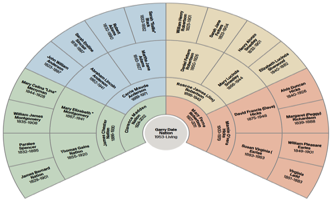
Nation Family Chronicles
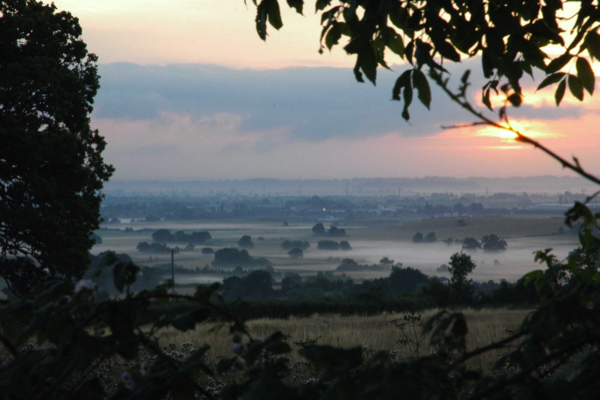
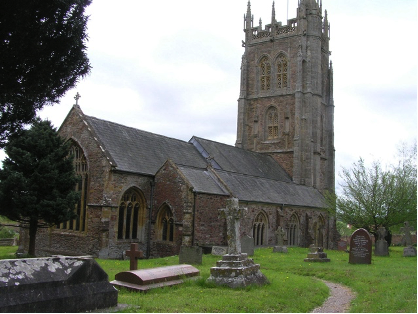
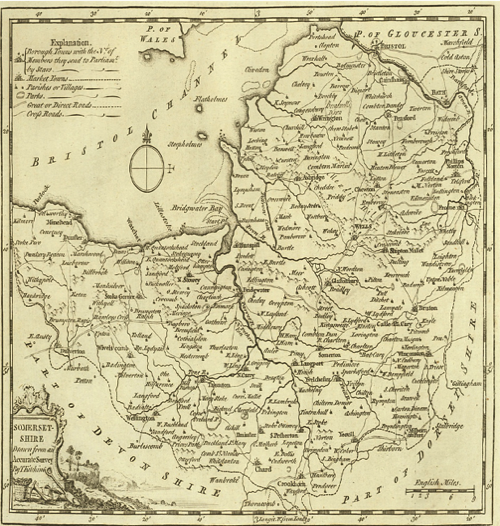
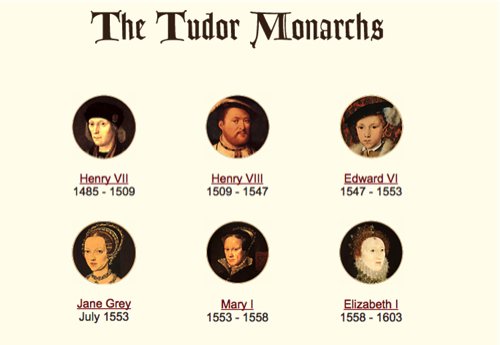
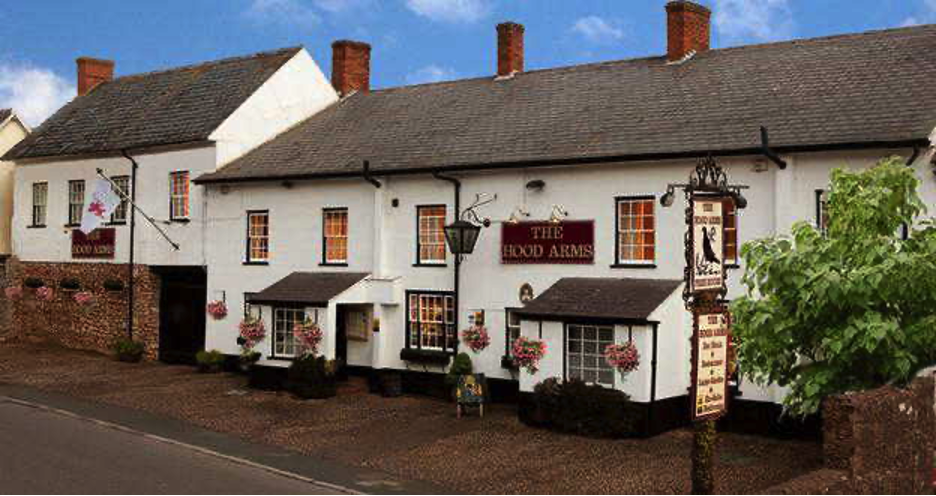
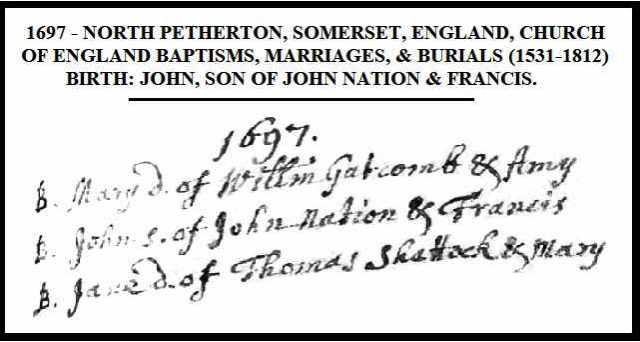
The year 1470 in England marked a high point in the Wars of the Roses, with the House of York's King Edward IV holding the throne—until he didn't. And it was the year of the Battle of Nibley Green, the last battle between private armies of feudal magnates.
It was also the birth year of a boy in Somersetshire who carried the Nation name. He grew up to marry a woman named Pascha Fenner, and together they would have two sons, Richard and John. John Nation was born in 1495 in the parish of Kingston St. Mary, Somerset, a village on the southern end of the the Quantock Hills four miles north of the major town of Taunton.*
Here is where we will start our Nation Family story.
*Source: Ancestry Family Trees
2
The Nation Name
Sometime probably late in the 14th century a certain English commoner, following a custom only as recent as the Crusades, gave one of his sons a biblical name: Nathan. In turn Nathan, following a more ancient custom, named a son after himself. Around this time, his Norman overlords instituted a poll tax that required every man, not just gentlemen, to be identified by a surname. Nathan's son took his father's name and called himself Nathanson. It did not take long for impatient Saxon tongues to slur Nathanson into Nation.*
*“English (West Midlands): most probably a variant of Nathan, altered by folk etymology under the influence of the English vocabulary word nation.” (Ancestry.com, surname Nation origin) Variants include Nathan, Naton, Netton, Nason (characteristic of Ireland), and a few others less common. (Source: Surname Database)

3
Somerset
The story of our Nation family begins in the western English shire (county) of Somerset, the likely place of origin of the Nation name, where to this day dwell a comparatively large number of persons with the name Nation. Well over half the people in the UK with the name Nation are found in the two neighboring, largely rural counties of Somerset and Dorset. Somerset occupies the elbow of land in southwest England separated from Wales by the Mouth of the Severn and the Bristol Channel. It is a land of high moors, rolling hills, and flat plains.
Of the climate, it has been written:
There is often a superabundance of wet weather, especially in the west; a drought is very unusual. The weather is seldom very hot in summer or very cold in winter…. Plowing can be done in much of England as early as February and as late as November…. The downs and uplands are often bathed in clear sunshine and blown over by crisp breezes while the river valleys are covered with a mantle of fog. On the moors and mountains the weather is often severe…and all over the island there are occasional though seldom prolonged periods of snow and freezing in winter.
Edward P. Cheyney, A Short History of England, rev. ed. (Boston: Ginn and Co., 1927): 7.
Settled since Paleolithic times, the region owns a rich and ancient history. The mysterious prehistoric monument Stonehenge is located here. Tradition holds that Joseph of Arimathea, known in the four Gospels as the man who lent his tomb to Jesus, led a band of Christians to settle here as the first bearers of the gospel to Britain. It was the site of the first successful Roman invasion of Britain in A.D. 47 and remained part of the empire for the next four centuries, most notably remembered in the Roman ruins of the city of Bath. During the Roman occupation, lead and silver mining in the Mendip Hills south of Bristol and Bath quickened industrial development in the region.
When the Romans departed in A.D. 410, the native Britons were left to defend themselves against the increasing incursions of the Saxons. If there really was a King Arthur, his Camelot was somewhere in Somerset (it has long been identified in tradition with Cadbury Castle, and Glastonbury Abbey is thought to be his burial place). After many generations of warfare and immigration, the Saxons won the territory and made it their own. Four centuries after the Romans withdrew from Britain, Alfred the Great fought off the Danes and rose to become the first king of a united Anglo-Saxon kingdom, and the base of his power was Somerset.
The Anglo-Saxons gave the place its name, apparently as a translation of the Celtic name by which the Britons called it.
The 'Sumorsaete' recorded in the Anglo-Saxon Chronicle and remembered in the motto of Somerset County Council were, so the language experts tell us, 'the people of the summer lands'. The Welsh/Celts, who were here before the Saxons, called it Gwlad yr haf, which means 'land of summer'. So, the Saxons invading these parts in the later 7th century described the area as the native Celts described it before them.
The sun shining on the bright green Spring grass of the Levels can be seen clearly from across the Bristol Channel, and is perhaps that which so struck those who lived here so long ago. Acres of green marshlands spreading deep inland meant that winter floods were over and rich summer grazing would soon be available. It was the land which came into its own in the summer, and the name the new owners gave to their principal settlement was appropriately the summer town, Somerton.
Celebrating Somerset, Official Guide. http://www.burrows.co.uk/somerset/07TheM.htm
When the Normans took possession of England, to maintain control over this key region they promptly built the first of many castles in the eastern border town of Penselwood. Somerset became a major center for the sheep and wool industry in the Middle Ages. It was (and still is) a significant agricultural region, and during the Tudor era its population grew as farming techniques improved.
England's equivalent to America's rural South, Somerset has been called the most quintessentially English of English counties. It is famous for its hard apple cider and for the cheese that originated in the town of Cheddar. In Somerset, they spoke—and still speak—a dialect and accent reminiscent of the Saxon tongue and the days of King Alfred: The S often sounds like Z and F like V, vowels are tight, and R's are hard. When Americans hear this speech, we might think of pirates. Or we might think of the Shire—Sean Astin's characterization of Samwise Gamgee in the Lord of the Rings movies featured an accent that resembles the speech of Somerset.

4
Our Nation Family in Tudor England
John Nation, who begins our story, was born in 1495 under King Henry VII, the first Tudor king. He and his wife Sarah had at least one son, William, born in 1510, at the very beginning of the reign of Henry VIII. We do not know where William was born, but his marriage to a woman from North Petherton named Catherine (1514-1596) indicates that he likely dwelt there as well. They also had at least one son born in 1542, also named William, presumably in the Somerset village of North Petherton. (Their relatively advanced age at his birth may indicate that they had other children we don't know of.)* William, Jr. was born in the late, declining days of Henry VIII, and came of age during the turbulent period of Bloody Mary and her attempt to force a nationwide return to Roman Catholicism from a burgeoning Protestantism begun under Henry.
The center of this religious/political turmoil was faraway London, but we should not underestimate the stressful effects of these disturbances on the country folk of the West. The church and the Christian faith were an integral part of their lives, not merely a private concern but the determiner of both civic obligations and social relationships. Some were zealous either for Protestantism or Catholicism, but most kept their heads down, prayed their prayers, and waited to see who was going to emerge on top of the conflict and confusion.
Queen Mary I died In November 1558, and on January 15, 1559, Elizabeth I was crowned. She would reign until her death in 1603 over one of the most dramatic eras of English history, an age of economic and territorial expansion, of an explosion of knowledge and culture, of war and peace, of ascent to dominance on the high seas and vigorous exploration and settlement of the New World.
*Source: Ancestry Family Trees

5
North Petherton
To William Nation (Jr.) and his wife (whose name we do not know but whose dates appear to be 1551-1595) was born a son. They named him after his father and grandfather. Young William was likely born in North Petherton, Somerset in 1565,1 which was the 7th year of Elizabeth's reign and a year after the birth of Shakespeare and Galileo.
On June 15, 1590 William Nation (III) was joined in marriage to 21-year-old Cressett Wilshire in North Petherton. We presume it was William's hometown, but we know it was Cressett's because her baptism is recorded in the church there on October 1, 1568.2 Cressett was the daughter of Edward and Susannah Wilshire. Edward was born almost 200 miles away in Stevenage, Hertfordshire, and his family line there goes back at least four generations.3
What brought him to North Petherton is unknown, but he did not thrive there. He died in 1581 not older than 31 years of age.
North Petherton is a village in the south-central zone of the shire near the Parrett River, about fifty miles south of Bristol, about ten miles north of the city of Taunton. Even during Saxon times, it was at the center of a large royal estate. It was noted in The Domesday Book as Nortperet, referring to its location on the northern, downstream location along the Parrett. (Yes, there is a South Petherton.)
King John hunted there and stayed in Bridgewater Castle. The great medieval poet Geoffrey Chaucer, author of The Canterbury Tales, served Richard II as Deputy Forester of the Royal Forest of North Petherton. In 1318, during the reign of Henry II, it was granted to North Petherton to be a market town and to hold a fair. It was a busy enough place for centuries, yet proudly retained its status as a village—claiming to be the largest village in England—until the 20th century when it officially became a town.4
The village had churches dating from the days of the Saxons (St. Peter's) and the Normans (St. Michael's). However, in the days of William Nation (and to the present day), the most impressive structure in the village was at its center: The Church of St. Mary the Virgin. Built in the 15th century, it has a 109 foot-tall, three-stage tower which was built on in the 1540's. To this day it is a striking architectural landmark.
William's occupation is unknown, but the statistical likelihood is that he was a husbandman or farm laborer (not a yeoman, for there is no evidence that the Nations had property holdings of any significance). Otherwise he might have been a craftsman or shopkeeper or common laborer, but farming remains most likely. Agriculture was (and is) the dominant industry in the parish, at that time primarily growing wheat, barley, and oats.5
William and Cressett Nation had a daughter, Agnes (b. 1592), and two sons, Henry (b. 1593) and Edward (b. 1595). All were born in the village of North Petherton. Henry Nation was born and baptized, according to church records, on June 10, 1593 in North Petherton. Sadly, his father and mother both perished in 1596, leaving the poor orphans to be raised by relatives. An epidemic must have swept through the town because William III's father William (Jr.) also died in 1596 and his mother also the previous year, such short lives in such an eventful era.6
As with his father, we may assume Henry was a farmer. When he came of age he married Thomasine Symes, probably between 1615 and 1618. Thomasine, the daughter of Robertt (sic) Symes and Joan Wilton, was born March 29, 1591. Her hometown was Pitcombe, Somerset, about thirty-five miles east of North Petherton. After marriage she and Henry Nation lived their whole lives together in North Petherton. Their first child Priscilla was baptized on August 22, 1619. On April 7, 1622 their second, a son, was christened George. Then was born John on Friday, April 25, 1625 when Henry was 31 and Thomasine 34. That was just less than a month after the son of the recently deceased King James I ascended the throne of Great Britain as Charles I. Finally came the birth of a third son to the Nation family on May 28, 1629, named Henry after his father.7
Their second son John Nation is our 10th great-grandfather. He was the first of four generations of our Nation fathers to bear that name.
1 Source: Ancestry Family Trees
2 England, Select Births and Christenings, 1538-1975
3 Source: Ancestry Family Trees
5 A P Baggs and M C Siraut, 'North Petherton: Economic history', in A History of the County of Somerset: Volume VI, Andersfield, Cannington, and North Petherton Hundreds (Bridgwater and Neighbouring Parishes), ed. R W Dunning and C R Elrington (London, 1992), pp. 300-306. British History Online http://www.british-history.ac.uk/vch/som/vol6/pp300-306 [accessed 20 September 2018].
6 Sources: Ancestry Family Trees; England, Select Births and Christenings, 1538-1975; Somerset, England, Church of England Baptisms, Marriages, and Burials, 1531-1812
7 Source: Ancestry Family Trees; England, Select Births and Christenings, 1538-1975
6
John Nation (I) and His Descendants
John was born at the time that Englishmen were beginning to establish a new England across the Atlantic. Just five years previous the Mayflower Compact was signed, and Plymouth Colony established in Massachusetts. The English and the Dutch began to compete for colonial positions on the upper Eastern Seaboard in America, the former establishing Massachusetts and New Hampshire and the latter New Amsterdam. We might wonder if Henry Nation had any notion that his family might someday find a place there. Meanwhile the English were busily settling Virginia and establishing other colonies.
In 1650 at the age of 25, John married Elizabeth Till. Elizabeth was born in North Petherton on August 12, 1627 to William Till1 and his wife Jane Boane Till.2 Together John and Elizabeth had four children. John (Jr.) was born August 22, 1651 in North Petherton. Mary arrived on the winter day of January 22, 1654, and sadly, died the same day. John, Jr. was four years old. It would be eight more years before another child entered the family. Christopher was born April 8, 1662 in the village of Broadway about 17 miles south of North Petherton. Finally came Henry (b. May 19, 1665 in North Petherton), named in honor of his grandfather who had died in 1653.3
John Nation (Jr.) came of age in North Petherton, and in 1671 at the age of 22 married a 16-year-old maiden named Elizabeth Betty. Elizabeth was the daughter of Edward (or Edmund) Betty (b. 1641 in Curry Rivel, Somerset)4 and Catherine Butt (b. 1645). Elizabeth's grandparents were Richard and Joyce Betty (paternal) and Martin Butt and Catherine Padmore (maternal). We do not know their birthdates, but they were likely in the 1620s, around the time of the Mayflower expedition. Elizabeth was the oldest child of the Bettys, and for a long time she was an only child. In 1666, she was joined by a sister, Mary; and in 1667 when she was 12, her mother gave birth to brother Richard Betty. Then in 1670 the family made room for a set of twin brothers, John and Timothy.5
Perhaps we can imagine, then, the motivations for the 16-year-old to leave home to marry a man six years her senior. About a year after their marriage (June 23, 1672), she and her husband had their first child. Named after his father and grandfather, he became the John Nation of the third generation.
About a year after John III's birth (1675), Elizabeth's mother Catherine Betty brought forth another set of twins, this time girls: Susannah and Joan. We don't know about Susannah, but Joan lived until 1716. Like her husband John, Elizabeth also had a sister named Mary to die in childhood: Mary Betty, d. 1675 at the age of nine.
Elizabeth herself had only a couple more years to live. 5-year-old John Nation III, an only child, lost his young mother who died at age 22. His father, though only 28, never remarried. It is probably a good supposition that young John's grandparents helped to raise him—especially the Bettys, who had a couple of small boys of their own. John's uncles John and Timothy Betty were, after all, only a couple of years older than he.
We do not have information about John Nation, Jr.'s occupation. He likely worked alongside his father until John, Sr.'s death in 1696 at the age of 47. We do know, however, that he also served as a churchwarden in North Petherton.6
At age 23, John III married 17-year-old Frances Parsons on May 16, 1696 in North Petherton. Frances was born May 21, 1678 in the northern Somerset village of Wraxrall (a name which may be colorfully translated “Buzzard Nook”) to Richard and Mary Parsons. Ten months after her marriage to John, Mary gave birth to a son, christened John Nation on March 23, 1697, the fourth by that name. Sometime later they had another son named William, who died as an infant or child on July 20, 1701.
In 1702, fifty-three-year-old John Nation (Jr.) died and was buried apparently in the village of Halse, some 13 miles southwest of North Petherton. He was soon followed in death by his son John (III), who died at the young age of 30 and was buried on May 11, 1703 in the village of Ash-Priors, about 12 miles southwest of North Petherton.7 The fact that these men died and were buried a modest distance from their hometowns may indicate that they were hired laborers, and we may even speculate that their deaths were work related.
It is worth noting that while these people did not travel widely, neither were they tightly tethered to a single town or village. It also makes sense that they would not be carried home for burial if they died in another town unless they owned property. It is clearly evident that the Nations were not landowners in England. That was a privilege held by a small percentage of the population.
In any case, Frances Parsons, now 25, was left with her six-year-old son John. But remaining with them also was her husband's 76-year-old grandmother, Elizabeth Till Nation.8
Elizabeth's brothers were still living, but otherwise there seem to have been no close relatives living close by. Life for the young widow and her son must have been extremely difficult. How difficult must life be to cause one to leave everything behind and make a radical new start in a new place? For within just a few years, this young woman, together with a very young boy and his elderly great-grandmother, will be finding their way in a whole new world.
1 William Till (b. 1600) is a later or last son of William Till, Sr. (b. 1568) the son of Thomas Tyll (b. unknown) and Agnes Walls (1568-1608) the daughter of Thomas Walls (b. unknown).
2 An interesting twist in searching out this family line came with a hint that Elizabeth Till was a direct descendant of the Woodville family, famous (or infamous, depending on one's point of view) for their role in the Wars of the Roses. Elizabeth Woodville, daughter of a commoner, became the wife and queen of King Henry VI and had a devastatingly divisive influence on his reign. The link to the Woodvilles turned out to be a false lead, however, and completely mistaken. It does not appear that our Elizabeth Till had any traceable connection to the Woodvilles and the Wars of the Roses. We can verify her parents through church records, and no further.
3 Ancestry Family Trees; England, Select Births and Christenings, 1538-1975; Somerset, England, Church of England Baptisms, Marriages, and Burials, 1531-1812.
4 Edmund/Edward Betty was the son of Richard Betty (1605-1655) the son of Robarte Betty. His mother's name was Joyce.
5 Ancestry Family Trees; England, Select Births and Christenings, 1538-1975
6 Somerset, England, Church of England Baptisms, Marriages, and Burials, 1531-1812
7 Ancestry Family Trees; England, Select Births and Christenings, 1538-1975; Somerset, England, Church of England Baptisms, Marriages, and Burials, 1531-1812; Somerset, England, Extracted Parish Records.
8 Some family trees also ascribe to her a daughter, Eleanor Nation, but those records have her born in the New Jersey colony, which doesn't square with known facts and cannot be otherwise documented. It is doubtless a confusion error. See note on the confusion of Eleanor Robins and Eleanor Nation in Chapter 3, Part 1, Note 6.
CHAPTER 1
THE NATION FAMILY
IN ENGLAND